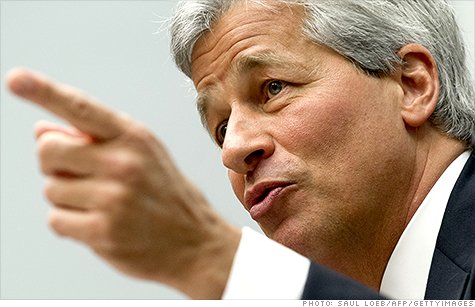Search News

Jamie Dimon said he will reveal the size of JPMorgan's trading losses on a conference call with investors Friday morning.
NEW YORK (CNNMoney) -- It's the moment we've all been waiting for.
JPMorgan Chase CEO Jamie Dimon will finally reveal the size of the bank's multi-billion dollar trading loss when the firm reports its quarterly results Friday morning.
The losses from what Dimon has deemed indefensible trades in an obscure corner of the derivative market could come in anywhere from $3 billion to $9 billion, according to news reports. The bank declined to comment.
JPMorgan is also expected to report a quarterly profit but investors will need to dig deeper to really see where the bank's revenues are coming from.
Dimon has said JPMorgan Chase (JPM, Fortune 500) will be "solidly profitable" in its second quarter, despite the trading loss. Analysts expect JPMorgan to earn 72 cents per share on roughly $22 billion of revenue in the second quarter.
But accounting quirks that banks use can sometimes make them look healthier than they are.
For example, JPMorgan can claim so-called debt value adjustments, or DVAs, as gains. DVA is calculated by how a bank's debt is valued by investors in a given quarter. If the value of the debt falls, it means that investors are more worried about the bank's health.
U.S. accounting rules allow banks to record a decrease in the value of its debt as a profit because they could theoretically buy the debt for a lower price and earn a return.
Another potential maneuver: in a low interest rate environment, banks can put securities, such as mortgage-backed bonds, up for sale and record what they would have earned from the sale as a profit even if there wasn't an actual transaction yet.
Dimon talked about booking $1 billion of such "nonrealized securities gains." Analysts say by selling some of these securities now, JPMorgan would sacrifices potentially lucrative profits down the road.
"Jamie Dimon is accountable to a lot of different players, including politicians and Joe Public," said Paul Miller, an analyst at FBR. "Seeing a headline number in an elevator showing a profit helps them, even if analysts don't buy it."
Analysts like Miller will quickly dig into the profits (or losses) that fall outside of DVAs, nonrealized securities gains and the so-called London Whale loss to see how the bank is actually performing.
"What I want to know is how much did they really make outside of all this noise? How much of the trade is left to unwind?" asked Miller.
What Miller says he'll also want to know is how much the chief investment office contributed to earnings over the past five years. It's unclear whether Dimon will break that out.
In his testimony on Capitol Hill, Dimon has already said it's likely that the bank will take back pay via so-called "clawbacks" from individuals responsible for the trading losses. He's expected to elaborate on the clawbacks during Friday's conference call.
JPMorgan and other big banks faced large headwinds during the second quarter, as M&A and IPO activity declined and lower interest rates created a difficult environment for deposits and lending.
Still, JPMorgan could see a few bright spots from growth in credit card and auto loans, where it's a big player, and from an overall increase in commercial lending.
Meanwhile, the multi-billion loss for JPMorgan isn't the only scandal afoot for the investment bank. JPMorgan has been contacted by regulators as part of an unfolding investigation into the manipulation of Libor, the global benchmark for interest rates.
JPMorgan is also being investigated for having rigged prices in the California and Midwestern energy markets, according to documents filed with the U.S. federal court by the Federal Energy Regulatory Commission.
Overall, JPMorgan's stock is down 15% since the firm announced its trading loss on May 10, but it's still up roughly 4% for the year.
Broadly, large bank stocks are up 14.8% in 2012 compared with a 7.7% gain for the S&P 500 (SPX), according to a note from Anthony Polini, a banking analyst at Raymond James. ![]()
| Index | Last | Change | % Change |
|---|---|---|---|
| Dow | 32,627.97 | -234.33 | -0.71% |
| Nasdaq | 13,215.24 | 99.07 | 0.76% |
| S&P 500 | 3,913.10 | -2.36 | -0.06% |
| Treasuries | 1.73 | 0.00 | 0.12% |
| Company | Price | Change | % Change |
|---|---|---|---|
| Ford Motor Co | 8.29 | 0.05 | 0.61% |
| Advanced Micro Devic... | 54.59 | 0.70 | 1.30% |
| Cisco Systems Inc | 47.49 | -2.44 | -4.89% |
| General Electric Co | 13.00 | -0.16 | -1.22% |
| Kraft Heinz Co | 27.84 | -2.20 | -7.32% |
| Overnight Avg Rate | Latest | Change | Last Week |
|---|---|---|---|
| 30 yr fixed | 3.80% | 3.88% | |
| 15 yr fixed | 3.20% | 3.23% | |
| 5/1 ARM | 3.84% | 3.88% | |
| 30 yr refi | 3.82% | 3.93% | |
| 15 yr refi | 3.20% | 3.23% |
Today's featured rates: